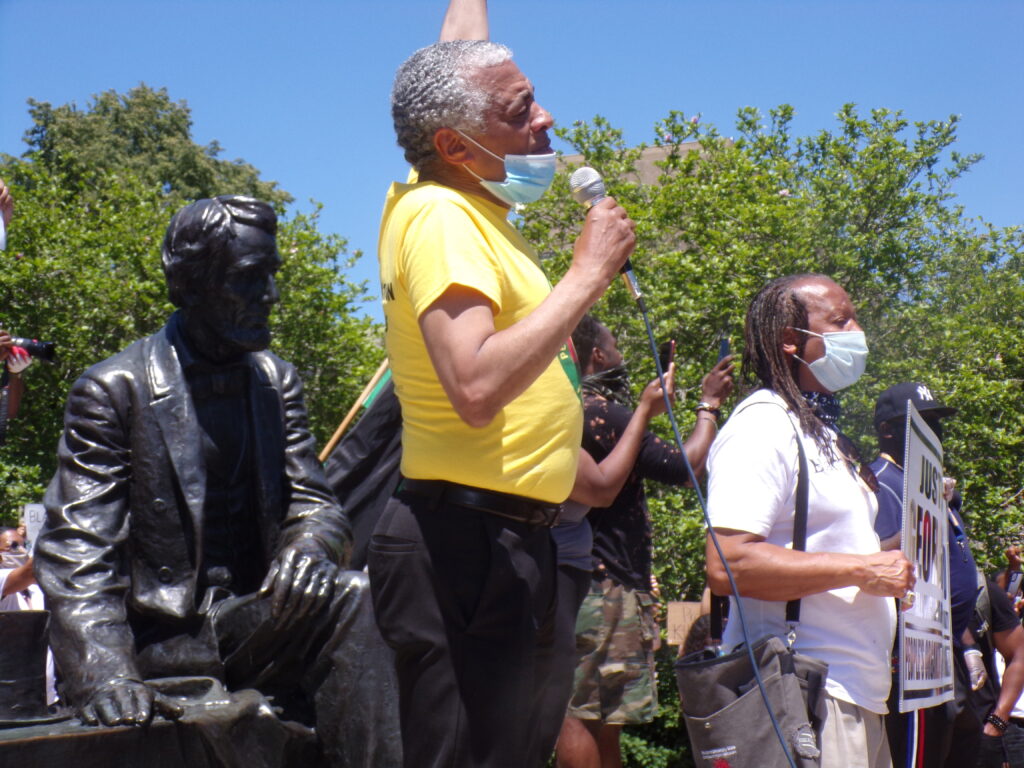Anatomy of a Protest: a Larry Hamm Lesson in the Use of Political Power

Forged in part by the Newark 1967 uprising, Larry Hamm has spent a life time as a nonviolent activist for justice, going back to his high school days and his time at Princeton University when he protested inequities on the leafy campus while simultaneously serving as a local school board member.
The founder and chairman of the People’s Organization for Progress (POP) has led some lonely actions in his lifetime, particularly lately in this gilded age, when most people didn’t want to see or hear of the troubles the country now faces in a deepening destructive crisis.
Saturday’s rally was not one of those ghostly occasions.
Neither was Hamm unprepared for the hundreds of masked people who found their way to the Lincoln statue to demand justice for George Floyd, killed by police in Minneapolis Minnesota last week. The days subsequent to the killing spawned strife and mayhem in cities around the country. Hamm, for his part, led a peaceful protest, in keeping with a life’s work defined by the example of Dr. Martin Luther King, Jr.
The anger out there now suggests that for many at this criticial juncture in our country’s history, peace is an insufficient instrument to get through to a cocooned establishment that inludes a Twitter-raging, divisive and hateful president and elected officials, media and institutions that in a substantial range of instances have abandoned the people’s work, and in some cases have abandoned it utterly.
“This is a perennial issue: nonviolent versus violent,” Hamm told InsiderNJ. “I don’t like hurricanes. I don’t like tornadoes. I can’t control a hurricane. I can’t predict when it’s going to come. I’m not going to condemn people in other places who are doing things differently. I’m not going to condemn rioters, but that’s not what I want to do. That’s not where I’m at, because I want to influence events in my area and the direction we think we should go. The conditions are different from place to place.”
In this instance, the closeness between Hamm and Mayor Ras Baraka – and a shared history of communicating on the ground level about those ground-level crisis events often, usually in fact, far below the headlines, made this occasion pro forma for the two leaders.
The People’s Organization for Progress decided unanimously last Thursday night to hold the demonstration for George Floyd. The members urged Hamm to let Mayor Ras Baraka know about the rally, and so the founder subsequently communicated with the mayor. “I told him what we were going to do in a long text and at the end of it, I invited him to speak.”
Baraka texted back, “Ok. I might be there.”
Hamm later received a call from the police – from a contact he knows and routinely works with – to discuss logistics ahead of the rally.
On Saturday morning, the day of the rally, he got a text from the mayor, who told Hamm he was going to address justice for George Floyd on the steps of City Hall and invited Hamm to stand next to him.
Hamm texted back, “Ok.”
The activist said based on the mayor’s public remarks he sensed Baraka had some information about possible plans for activities that clashed with a peaceful action. Later, at the Lincoln statue, “I felt compelled to speak on it. I know how these things turn out. I was not aware of any specific source of anger or violence, but it we allowed that to occur, the headline would have been ‘protesters out of control.’ It wouldn’t have been, ‘thousands peacfully demand justice.'”
Ultimately, Hamm said, “The main issue is not whether protests are violent or not. The main issue is police brutality and murder of unarmed civilians. It we eliminate police brutality and stop the murder of unarmed civilians I think the violent protests will subside.”







